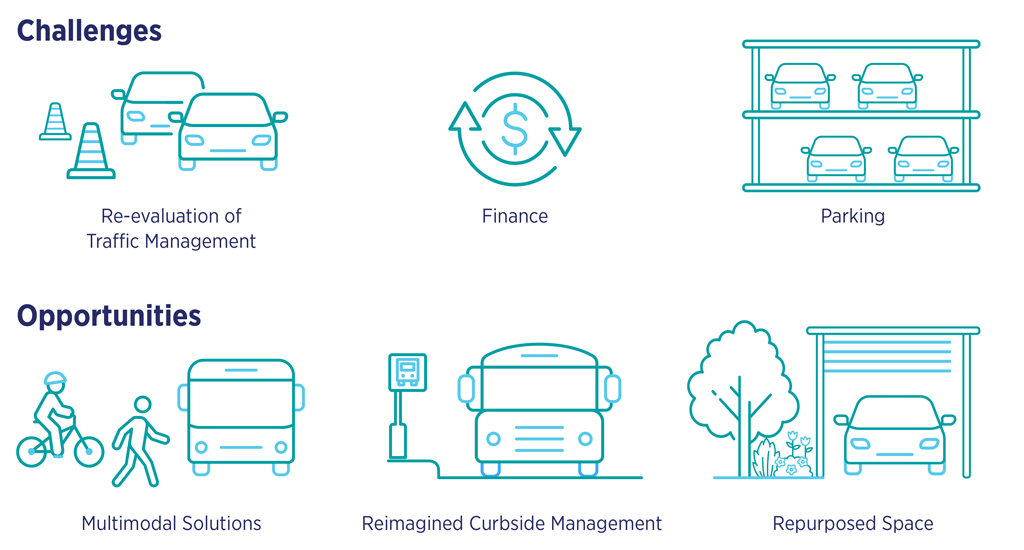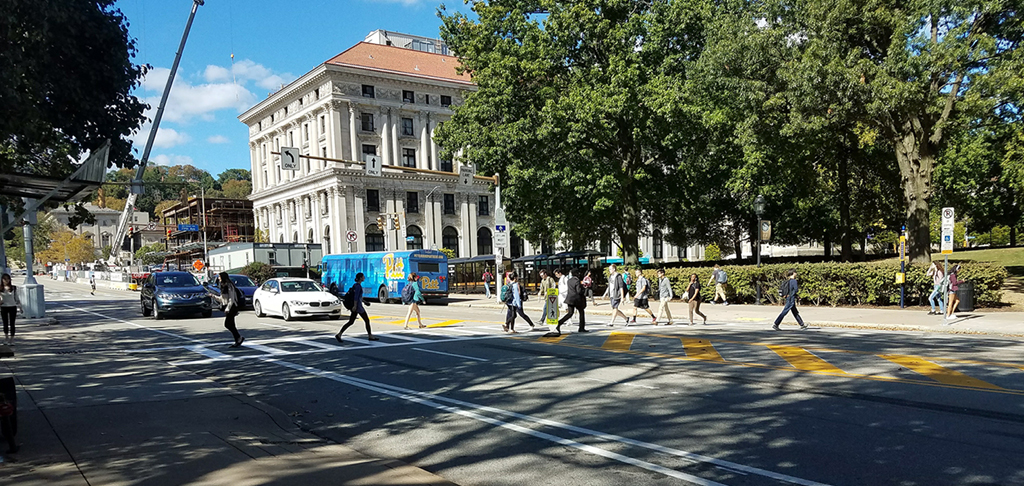Forward-thinking insights focused on a more sustainable tomorrow.
Navigating the Future of Autonomous Vehicles on Campus
Expectations for colleges and universities are continuously evolving to meet the needs of a changing society and to keep pace with shifting demographic trends and technology. Higher education institutions continue to expand the range of interdisciplinary and applied degrees, leading to increased travel demands for students integrating multiple departments and off-site experiences. These changes are causing new demands and expectations for the transportation systems that support college and university campuses. Increasing transportation costs and interest in more sustainable transportation systems are leading the current generation to embrace alternatives to personal automobiles. This shift in user groups has influenced travel behavior and prompted the need for new transportation systems in and around higher education campuses.
Planning for an Unpredictable Future
The accelerating pace of technological innovation is significantly affecting campus mobility on several distinct but related fronts. The challenge for colleges and universities is to provide a variety of flexible transportation options that allow for overall campus mobility, while providing safe, convenient, and efficient access to off-campus destinations and supporting future campus development.
Autonomous vehicles (AVs) are just one innovation that is leading the way in reimagining the daily operations of campus life. These vehicles are designed to drive themselves from point A to point B in an “autopilot” mode using navigational technologies and internal sensors. For larger institutions or campuses located in an urban setting, AVs are one solution that would satisfy the demands triggered by student expectations for integrated mobility and could ease the effects of traffic congestion. Many institutions are grappling with the future of incorporating these vehicles into their campus environment, with the path uncertain at best.
Most are aware that AV integration into their campuses is on the horizon; it’s not a matter of if, but when. Focus has been placed on anticipating the timeframe for when the implementation of these vehicles will happen, as well as the impact that this shift will have on higher education as a whole. Every institution is responding to the demands, changes, and needs of their student population differently. Planning begins with:
- Understanding the context with which the implementation needs to happen and the extent of the integration
- Anticipating the needs of the campus community
- Identifying how the existing transportation systems can be improved to address future campus priorities
Balancing Challenges and Opportunities
For successful AV integration, efficient planning is essential, including reevaluating traffic management plans. Roadways will change with the use of AVs and campus traffic will naturally be affected. Transportation planning will be essential to anticipate the effects these new vehicles will have on campus. However, with the uncertainty of when these new vehicles will be implemented and the ease with which they are integrated, managing new traffic patterns within the overall campus master plan will be an obstacle. Only time will tell if the use of AVs will alleviate traffic congestion or result in an increase in vehicles on the road.
The day-to-day operations of the campus is another factor affecting AV integration. Curb management will be important as colleges and universities plan for organizing drop-off and pick-up areas. These designated areas will need to be reconfigured for AV requirements. Zoning codes will also be adjusted to accommodate these newly designed areas and anticipated shifts in parking demand.
Along with changes to the roadway, AVs will dramatically alter the landscape of parking. Currently, the demand for on-campus parking can be an ongoing headache. There is not enough parking to satisfy the demand, while the costs to construct continue to rise. AVs could reduce the parking demand on campus, eliminating the biggest area of contention for most institutions. Parking revenue funds the capital costs, operations, and maintenance of many campus transportation systems.
The question then becomes, do we retrofit all parking facilities to accommodate AVs or do we redevelop select sites knowing that, even with the integration of AVs, there will always be institutions with student commuters and the need for parking facilities?
Parking garages will be more automated and interconnected, as they will serve multiple purposes, such as recharging stations.
As master plans move forward, along with the impending future of AVs, colleges and universities will need to weigh the options of holding off on building additional parking structures or continuing construction to meet the demand.
Likewise, underutilized facilities could be converted for AV use and storage, leasing parking facilities and sites to private companies supplying their AVs on campus.
In the future, parking facilities will have to be repurposed into mixed-used parking garages with a more efficient use of land and maximal use of space. Master plans will have to address the shifting land use patterns that are anticipated.

AV Integration Is Not One-Size-Fits-All
There is no one-size-fits-all solution for AV implementation on campus. Large, urban institutions will be affected differently than small, rural campuses and potential solutions will also vary. Colleges and universities need to proactively plan—and remain flexible in their planning. It will be imperative for administrators and planners to evaluate the potential impact of AVs within their campus.
With large, urban institutions, the potential for AVs on campus is already here. These campuses have good transit systems in place and see the impacts of ride sharing. AV implementation will be advantageous for first- and last-mile connectivity. While this type of institutional setting is ideal to first introduce AVs, more planning and modifications are needed as these institutions are land constrained and every inch of curb will need to be evaluated.
College-town institutions have an impact on their surrounding communities, which will factor greatly into their AV integration. They deal with a mixed-mobility contingent, with students and staff often living in surrounding suburbs. Addressing AVs on campus will be the most complicated for this group with regards to how far the AV infrastructure would extend into the community and how it would affect both environments. These institutions will require more in-depth planning with a variety of studies and scenario planning to accommodate their needs.
Small, liberal arts institutions have a close community feel with many students living on-campus. The challenge of AVs will have less campus impact, with lower and slower penetration. These institutions have minimal structured parking, and therefore more room for innovation and adaptability. However, the slower penetration of AVs may not justify near-term infrastructure investment.
While these are just a sample of the institutional archetypes that would be affected by AV implementation, they are not inclusive of every type of educational environment.
VHB has partnered with more than 250 higher education clients to develop transportation solutions as they plan for the future, including helping them address issues of growth, uncertainty, changing expectations, and constrained resources. Client partners we are already helping as they plan for campus redevelopment with the deployment of AVs include:
- The Princeton University Campus Plan sets the stage for long-term growth on the campus. VHB led the transportation elements of the plan which factored large into the setting and the scenarios evaluated. Princeton wanted to retain long-term flexibility of the land but recognized that there is a short-term need to continue to provide parking. Simultaneously, they are looking to reduce overall parking demand. VHB helped shape the overall plan for mobility including the mix of structured parking, balancing use of land, cost, and likely longevity of the assets.
- Washington University in St. Louis recognized that parking needs are changing and tapped VHB to provide strategic parking and transportation advice. This included the development of a Long-Term Strategic Parking and Transportation Plan, which helps position their parking assets to respond to short-term needs, while positioning for long-term vision. VHB has remained engaged, helping the organization transition to a best-in-class, using data to drive decisions. Part of the effort included advising on a parking garage designed to allow a great degree of flexibility and ultimately be converted to non-parking space, if warranted.
- University of Pittsburgh’s Transportation Master Plan was developed to identify challenges with mobility and gaps in connectivity on and near campus. A holistic transportation strategy was developed that incorporates all modes and seeks to meet current and future needs for connectivity, mobility, safety and sustainability. At the center of much CAV testing, Pitt is keenly aware of the coming changes in urban mobility. The Master Plan includes careful balancing of short-term needs without over-investing in long-term assets that could become obsolete before the end of their design life. Pitt is already a leader in use of transit by employees; the plan looks to programmatic and non-infrastructure investments to reduce parking demand.

How VHB Can Help
Contact Nat Grier, PE, ENV SP to learn more about our innovative and forward-thinking integrated service solution approach and how we can help navigate the future of AVs on your campus. For further information on our campus mobility experience, click here.



